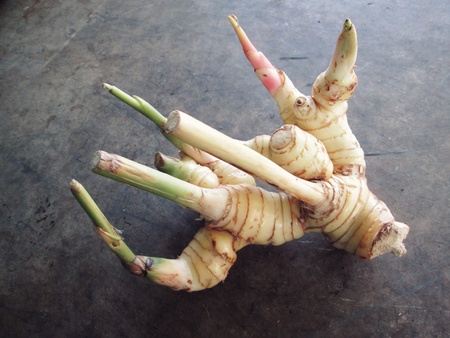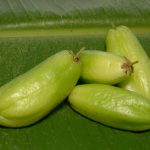
Trawling the superfoods in the local retailer always throws up some intriguing surprises. Firstly, you find galangal and it looks to all intents and purposes like root ginger. In fact it is commonly mistaken for being just that. One difference is the pink tinge near what is called the ‘tail’ which ginger doesn’t have. You then read that whilst it tastes like a rougher cruder version of that famous root, it actually has a nutrition reading list similar to curcumin and turmeric.
So we enter the fascinating world that is galangal and potentially one of the best cancer fighting agents around.
Source
Galangal belongs to the ginger or Zingiberaceae family and has been a staple and unique flavour in its home world of Thailand. Thais call the root kha.
There are clearly a few species, four to be precise within the genus Alpinia and we know that there are a number of confusing issues relating to these different species, especially their health properties. All of them have been examined to differing extents and we in FoodWrite exercise caution when comparing such species. We know of at least one well known web-site which has muddled the medical benefits
One key plant species is Alpinia galangal (also called Languas galangal) which is known as greater galangal or simply Thai galangal.
One other plant species name is known as Alpinia officinarum (Hance) Farw (used to be Languas officinarum (Hance). This may have even more potent properties. The other common names are ‘lesser galangal’ or smaller galanga,” is also commonly called “Southern Ginger,” “Lam Ginger,” “KaoLian Ginger,” “India Root,” “East India Catarrh Root,” “Rhizoma Galangae,” “Kaempferia Galanga,” or “Red Nutmeg” (Manual of Taiwan Vascular Plants, 1997).
We have tried growing it in the greenhouse but unsuccessfully!
Culinary Use
The root or rather rhizome is used similarly as ginger for a start where it can be grated or sliced to form a base for stir-fries. It almost tastes a bit like a toned down version of Wasabi. It is also used heavily in various salads and soups. Famous Thai dishes include the soup, thom kha (tom ka gai) whose flavour is famous for its soft spicy overtones. You also find it delightfully infusing coconut based soups which are tart, spicy and slightly sweet.
The flavour then is citrus, earthy, pithy, slightly spicy and musky and leaves a slightly tingling sensation. Many familiar with Asian gingers etc. find that galangal has a ‘cooling’ effect whereas ginger has a ‘heating’ effect. There is no lingering impact with galangal.
Store in the fridge. Galangal is not as easy to find as ginger in Western grocers but it can be substituted with it. You just have to use less because the flavour is so much more pungent and dare I say rougher and harsher.
The volatiles in the essential oil are characterised (Raina et al., 2014).
The Russians and the Latvians, Lithuanians and Estonians (The Baltic states) use the root to flavour vinegar and the famous liquor Nastoika (Grieve, 1931).
History Surrounding The Benefits
The root is found throughout India, China and much of South-East Asia. It is often referenced in Ayurvedic medicine and has been used in folklore medicine, even as far as the Middle-East. In these parts of the world the rhizome was used as a stimulant and for relieving flatulence and wind (calminative agent). These benefits are rather like ginger.
In ancient and medieval Europe, the root was used in perfumes where it has a rosy smell with a hint of spice (Simonetti et al., 1991).

Health Benefits
Galangal has been the target for many cancer studies and rather like turmeric capable of reducing general and specific forms of inflammation. One caveat, it is not necessarily as good as a cancer prevention drug but it offers some unique benefits in reducing some chronic conditions.
(1) Fighting Cancer
Galangal has been used in various animal and human cancer studies.
(2) Antimicrobial benefits
The essential oil of A. officinarum has some antioxidant activity and is relatively potent against a variety of food spoilage and food poisoning bacteria such as Bacillus cereus, Staphylococcus aureas, Pseudomonas auroginosa, and Escherichia coli. It is not yet showing any activity against fungal species or yeasts like Aspergillus niger or Candida albicans (Sridya et al., 2010).
Galangal actually has some antimicrobial/antifungal properties however it has been tested in a synergistic mix with rosemary (Rosmarinus officinalis) and lemon Iron Bark (Eucalyptus staigerana) extracts (Weerakkody et al., 2011). Clearly various Galangal root extracts could work well with other natural sources to create a strong agent in protecting and extending product health.
(3) Enhancing and improving appetite
(4) Improves blood flow especially in the brain.
– One component in galangal is 1′-Acetoxychavicol acetate (ACA) which is claimed to reduce memory loss by improving ketone body production in nerve cells (Kojima-Yuasa et al., 2016). This level of support for the brain potentially means there is a way of halting a decline in age-related cognitive degeneration.
It is also well known for tackling dyspepsia, vomiting and stomach complaints. The antiemetic property is important (Shin et al., 2002).
Precautions
- do not use if pregnant.
- do not use if you suspect you have a peptic ulcer.
Products
N.B. This post contains links to our affiliate marketing partner. Please read our affiliate disclosure.
Legal Disclaimer Concerning Products On This Web-Site
The products and the information provided about specific products on or through this site have not been evaluated by the United States Food and Drug Administration or by any other national regulatory body and are not intended to diagnose, treat, cure or prevent disease. The information provided on this site is for informational purposes only and is not intended as a substitute for advice from your physician/doctor or other health care professional or any information contained on or in any product label or packaging. You should not use the information on this site for diagnosis or treatment of any health problems or for prescription of any medication or other treatment. You should consult with a healthcare professional before starting any diet, exercise or supplementation program, before taking any medication or if you suspect you might have a health problem.
References
Grieve, M, editor. (1931) Galangal. In: A Modern Herbal. New York: Hafner Press.
Kojima-Yuasa, A., Yamamoto, T., Yaku, K., Hirota, S., Takenaka, S., Kawabe, K., Matsui-Yuasa, I. (2016) 1′-Acetoxychavicol acetate ameliorates age-related spatial memory deterioration by increasing serum ketone body production as a complementary energy source for neuronal cells. Chem. Biol. Interact. 257 pp. 101-9. doi: 10.1016/j.cbi.2016.07.031. Epub 2016 Jul 29.
Manual of Taiwan Vascular Plants. (1997) The Executive Yuan, Taiwan: Published by the Top and Supervising Committee of Agriculture. Available from: http://subject.forest.gov.tw/species/vascular/index.htm.
Raina, A.P., Verma, S.K., Abraham, Z. (2014) Volatile constituents of essential oils isolated from Alpinia galanga Wild. (L.) and A. officinarum Hance rhizomes from North East India. J. Essen. Oil Res. 26(1) pp. 24–8 (Article)
Shin, D., Kinoshita, K., Koyama, K., Takahashi, K. (2002) Antiemetic principles of Alpinia officinarum. J. Nat. Prod. 65(9) pp. 1315–8.
Simonetti, W., Simonetti, G., Schuler, S. (1991) In: Schuler S, editor. Simon & Schuster’s Guide To Herbs And Spices. Published by Fireside, Ontario. ISBN: 067173489X.
Srividya, A.R., Dhanabal, S.P., Misra, V.K., Suja, G. (2010) Antioxidant and antimicrobial activity of Alpinia officinarum. Indian J. Pharm. Sci. 72(1) pp. 145–8
Weerakkody, N.S., Caffin, N., Lambert, L.K., Turner, M.S., Dykes, G.A. (2011) Synergistic antimicrobial activity of galangal (Alpinia galanga), rosemary (Rosmarinus officinalis) and lemon iron bark (Eucalyptus staigerana) extracts. J. Sci. Food Agric. Feb;91(3) pp. 461-8. doi: 10.1002/jsfa.4206. Epub 2010 Oct 28.

Leave a Reply